The Deep Familiarity of Donald Trump
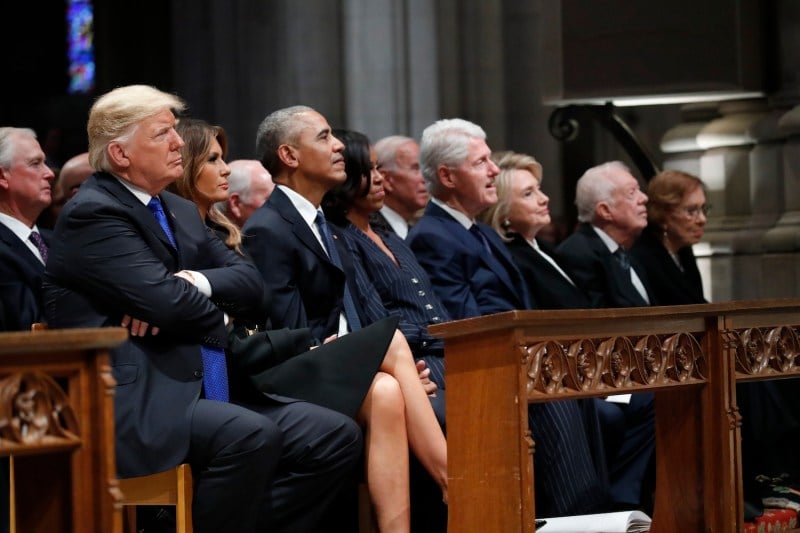
The Deep Familiarity of Donald Trump
He’s not wrecking postwar U.S. foreign policy. He’s bringing it to its logical end.
Donald Trump, Melania Trump, former President Barack Obama, former first lady Michelle Obama, former President Bill Clinton, former Secretary of State Hillary Clinton, and former President Jimmy Carter and former first lady Rosalynn Carter, listen as former President George W. Bush speaks during the state funeral for former U.S. President George H. W. Bush at the Washington National Cathedral on December 5, 2018 in Washington. Alex Brandon – Pool/Getty Images
U.S. President Donald Trump is often cast as a wrecking ball—an insurgent bent on tearing down the pillars of American power and global leadership. To his supporters, he’s a revolutionary; to his critics, a dangerous aberration. But both views miss the deeper story. Trump is not a break with the recent past—he is its logical conclusion.
Far from shattering a stable order, Trump has exposed its previous fragility. His rise is the culmination of a decades-long erosion in Western political leadership—marked by strategic drift, inflated promises, and chronic avoidance of hard choices.
U.S. President Donald Trump is often cast as a wrecking ball—an insurgent bent on tearing down the pillars of American power and global leadership. To his supporters, he’s a revolutionary; to his critics, a dangerous aberration. But both views miss the deeper story. Trump is not a break with the recent past—he is its logical conclusion.
Far from shattering a stable order, Trump has exposed its previous fragility. His rise is the culmination of a decades-long erosion in Western political leadership—marked by strategic drift, inflated promises, and chronic avoidance of hard choices.
The dysfunction didn’t start with Trump. He simply stopped pretending that it wasn’t there.
Since the end of the Cold War, Western democracies have struggled to reconcile their ambitions with their capabilities. Leaders across the spectrum embraced globalization without cushioning its domestic shocks, expanded international commitments while slashing the funding for them, and celebrated democratic ideals even as they eroded public trust through contradiction and complacency.
Over time, these failures of leadership have reshaped life across the West, shifting risk onto ordinary citizens and triggering cascading crises. The costs have fallen the hardest on the least privileged—soldiers sent to unwinnable wars, workers displaced by trade and automation, and communities ravaged by economic and public health shocks.
It may seem strange to think of Trump—in his crusade to decimate the federal bureaucracy and redraw the global map—as a continuation of anything. Yet, on inspection, his policies and pathologies—while more extreme—bear unmistakable resemblances to those of his predecessors. What sets him apart is the brazenness with which he resurrects approaches that have already been shown to fail.
To confront the crisis that Trump represents, he must be seen not as an outlier, but as an inheritor—a symptom of broader political failure. The damage cannot be undone by defeating him alone, or by restoring a status quo that was already discredited.
What’s needed is a deeper reckoning—with the illusions, evasions, and complacency that made his rise possible.
Nowhere is the post-Cold War syndrome of political evasion more visible than in the West’s approach to security. The collapse of the Soviet Union created an extraordinary opportunity to reimagine the European order, consolidate peace, and minimize future risks. Instead, a generation of Western leaders embraced a strategy that did not add up, mortgaging their countries’ security to a vision that they then declined to adequately fund.
For four decades, NATO had been a model of discipline and resolve. Through nuclear standoffs, crises over Berlin, and relentless Soviet pressure, the alliance not only deterred war but also nudged its adversary toward detente, arms control, and ultimately, a peaceful dissolution.
Yet after 1991, that clarity gave way to drift. Leaders debated whether to integrate Russia into a common security framework—as West Germany had been after World War II—or to expand NATO and reinforce its military posture. Either option would have been bold and internally consistent.
Instead, the West chose contradiction: It expanded NATO while weakening its foundations. Between 1999 and 2020, NATO admitted 14 new members, including several on Russia’s border. Yet while its security guarantees grew, its defense capacity shrank. U.S. troop levels in Europe fell from more than 320,000 service members in the late 1980s to 70,000 by 2013—the year that the last American tank left the continent. Britain, France, and Germany made comparable cuts.
This wasn’t just a military miscalculation—it reflected a deeper political failure. In much of the West, NATO enlargement was an elite-driven project, pursued with little public debate. Leaders spoke of democracy promotion and stability but failed to explain to their citizens why they should bear the cost of defending faraway countries. Expansion remained politically viable only so long as it appeared cheap and low risk. So they presented it as such. When Moscow turned hostile, Western leaders hesitated again—unwilling to ask electorates to support serious deterrence after years of supposedly cost-free security.
The result was a dangerous credibility gap. Article 5, NATO’s mutual defense clause, is only as strong as the belief that it will be honored. Yet some new members entered the alliance with almost no military capability. When the Baltic states joined, they had just three tanks between them. A 2016 study by the Rand Corp. concluded that Russian forces could overrun Latvia and Estonia and reach their capital cities in under 60 hours—leaving NATO with the impossible choice of nuclear escalation or retreat. Would Washington risk Chicago for Riga? And even if it would, would Moscow believe it?
In theory, such vulnerability should have triggered urgent reinforcements. In practice, complacency prevailed. Military spending among pre-1999 NATO members declined from an average of 2.3 percent of GDP in the 1990s to just 1.7 percent in the decades that followed. Newer members often spent even less. NATO didn’t even approve a formal defense plan for the Baltics until 2010—six years after they joined.
Western leaders initially wagered that Russia could be drawn into cooperation. They invited Moscow to join what then became the Group of Eight and a consultative NATO-Russia Council. For a time, the approach seemed plausible: Russian President Vladimir Putin allowed U.S. forces to transit Russian territory during the war in Afghanistan and spoke the language of partnership.
But by the late-2000s, that illusion crumbled. Putin’s 2007 Munich speech, the cyberattack on Estonia, and the invasion of Georgia in 2008 signaled a turn to confrontation. After Russia’s 2014 invasion of Crimea and the subsequent war in Ukraine’s Donbas region, the threat was undeniable. NATO’s response—a modest rotation of battlegroups through front-line states—was largely symbolic.
NATO expansion was not doomed to fail. But it required preparation that never came. With proper investments in front-line defense and a strategy for those left outside the alliance, the project could have worked. Expansion gave Eastern European states—which had feared exactly the kind of Russian revanchism that later materialized—the confidence to pursue democratic reforms.
But the foundations remained fragile. Western leaders overpromised and underdelivered, avoiding the domestic political costs of real deterrence.
In the end, the Baltics were spared not by deterrence, but by Putin’s priorities. Had Putin focused on Estonia’s Russian-speaking city of Narva instead of Kyiv, NATO’s bluff might have been tested. What saved them was Putin’s obsession with restoring the medieval territory of “Kievan Rus,” which led him to order his troops south instead of north.
The same shortsightedness marked the 2008 decision to promise NATO membership to Georgia and Ukraine without a timeline, road map, or strategy. Rather than enhancing security, the move gave Russia a reason to strike preemptively, before those countries could be integrated. It was the illusion of protection, without the substance.
Western responses to Russian aggression followed a familiar pattern: hesitant, piecemeal, and insufficient. After Russia’s annexation of Crimea, sanctions were imposed but proved to be too limited to deter further escalation. Military assistance to Ukraine was sporadic, reactive and constrained by fears of provoking Moscow.
Even as Russia’s ambitions became increasingly clear, many Western leaders stalled, hoping the crisis would resolve itself.
A more coherent strategy—robust arms shipments, comprehensive training, and early intelligence support—might have deterred Russia’s full-scale invasion of Ukraine in 2022, or at least blunted the initial assault. But under former U.S. President Barack Obama and Chancellor Angela Merkel, lethal aid was withheld. After the invasion, then-U.S. President Joe Biden pledged support for “as long as it takes,” but ended up delivering too little, too late.
This was not a question of resources. Over the same two decades, the U.S. spent more than $4 trillion on the wars in Iraq and Afghanistan—conflicts that became case studies in the syndrome of irresponsibility shaping recent governance. What began as focused missions intended to destroy terrorist camps or eliminate weapons of mass destruction devolved into open-ended occupations, marked by poor planning, mission creep, and political evasion. Besides costing hundreds of thousands of lives, they disrupted regional stability, empowered Iran, and undermined U.S. credibility abroad. At home in the United States, they corroded democratic norms through mass surveillance, indefinite detention, and an expanding national security state.
Viewed in this light, Trump’s foreign policy was not a clear break from the past—it was a reckless escalation of past trends. He criticized his predecessors but replicated their worst habits: incoherent strategy, impulsive decisions, and disregard for long-term planning.
For years before the 2022 war, Western leaders downplayed the threat of Russian revanchism. Trump dismisses it outright, blaming Ukraine for its own invasion and repeatedly praising Putin.
Even as tensions grew, Western governments continued to shrink their military budgets and reduce troop numbers in Europe. Trump’s defense secretary, Pete Hegseth, has promised even deeper cuts and further withdrawals. Every U.S. president since George W. Bush quietly pressed NATO allies to spend more. Trump openly threatened to abandon them if they didn’t.
Diplomatic friction between the United States and Europe is nothing new—recall the “freedom fries” of 2003 and State Department official Victoria Nuland’s infamous expletive about the EU in 2014. Trump repeatedly picked fights with the continent’s leaders. Trump hopes to focus on the rivalry with China—just like Obama, with his “pivot to Asia,” and Biden after him.
In the Middle East, Trump embraced and deepened long-standing contradictions in U.S. policy. Successive presidents had continued to arm Israel while turning a blind eye to the expansion of West Bank settlements. Trump hinted that he would accept Israeli annexation of the territory and even suggested that the U.S. should take control of Gaza and resettle its Palestinian inhabitants.
On Iran, previous administrations tried to curb Tehran’s nuclear program and regional influence through a mix of sanctions and diplomacy. Trump pursued the same goals through confrontation—tearing up the multilateral nuclear deal and ordering the assassination of a senior Iranian general.
Earlier presidents had mostly paid lip service to human rights and international law—yet they still refused to sign international conventions on enforced disappearances, migrant workers, and anti-personnel mines, or to accept the jurisdiction of the International Criminal Court (ICC). Trump dispensed with the nuances, withdrawing the United States from the United Nations Human Rights Council and imposing sanctions on the ICC itself.
Apart from a few theatrical ideas—such as annexing Greenland or Canada—Trump’s foreign policy has reflected not innovation, but escalation. He inherited the post-Cold War playbook—unilateralism, overreach, evasion—and ran it with less discipline and greater disregard for consequences. His foreign policy is not new: It is a louder, riskier remix of what came before.
Treating Trump as a mere anomaly—a product of partisan dysfunction or cultural backlash—misses the deeper reality. Rather than an outlier, he exemplifies in extreme form the characteristic pathologies of post-Cold War governance—reactive leadership, inflated promises, strategic drift, and chronic avoidance of hard choices. Trump did not create these trends. He rode them to power, and then he deepened them.
Recognizing the continuity is not meant to downplay Trump’s uniquely dangerous traits. His refusal to accept electoral defeat, his encouragement of political violence, and his open contempt for legal constraints place him in a category apart. His admiration for authoritarian tactics and revival of long-discredited ideas—such as territorial expansion—underscore the threat that he poses. But the failures that enabled him—underfunded foreign ambitions, unequal economic outcomes, and eroded institutional trust—were bipartisan and decades in the making.
Trump promises to force China to trade fairly—but so did the administrations of Clinton, Bush, Obama, and Biden. He pledges to restore the American dream without addressing structural inequality. He vows to deter adversaries while proposing deep defense cuts. His economic agenda favors the wealthy even as he speaks for the working class.
In all these ways, Trump’s approach mirrors the contradictions of his predecessors. His government-by-decree may look unconventional, but the policies themselves are familiar.
To that extent, the effort to defeat Trump cannot begin with him alone. It requires a deeper reckoning: a recognition that he is not the cause of the West’s unraveling—but its most dangerous symptom.
Daniel Treisman is a professor of political science at the University of California, Los Angeles, and co-author of Spin Dictators: The Changing Face of Tyranny in the 21st Century.
More from Foreign Policy
-

An illustration shows a golden Cybertruck blasting through a U.S. seal of an eagle holding arrows and laurel. Is America a Kleptocracy?
Here’s how life could change for the rich, poor, and everyone in between.
-

The flag of the United States in New York City on Sept. 18, 2019. America Is Listing in a Gathering Storm
Alarms are clanging at the U.S. geographic military commands around the globe.
-

U.S. President Donald Trump shakes hands with Supreme Court Chief Justice John Roberts during Trump’s inauguration in Washington, D.C. The U.S. Judicial Crisis Is Uniquely Dangerous
But other democracies provide a roadmap for courts to prevail over attacks from the executive branch.
-

An illustration shows a golden Newtons cradle with Elon Musk depicted on the one at left and sending a globe-motif ball swinging at right. Elon Musk’s First Principles
The world’s richest man wants to apply the rules of physics to politics. What could go wrong?
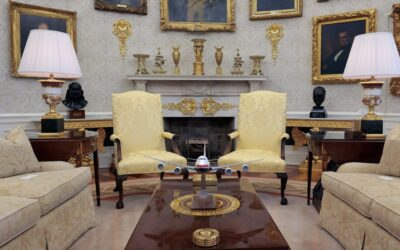
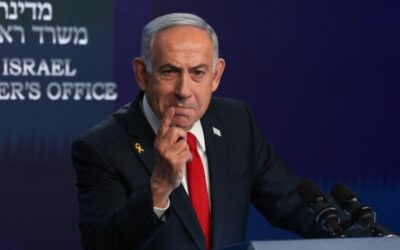


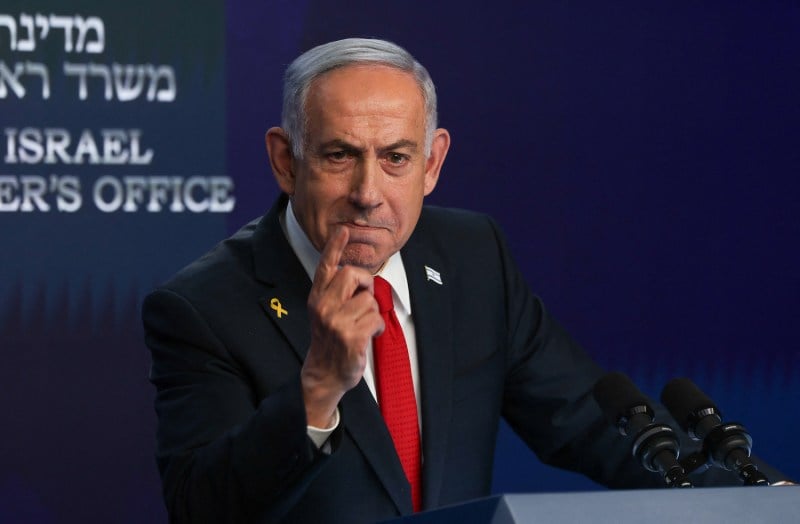
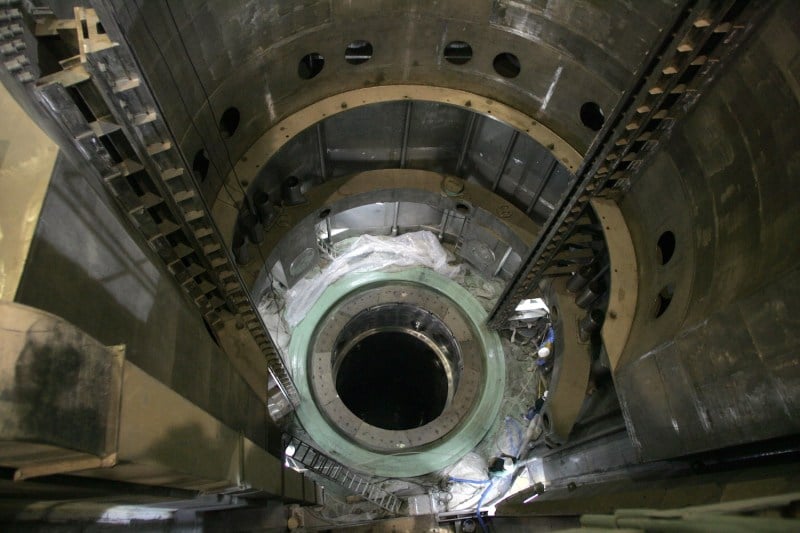

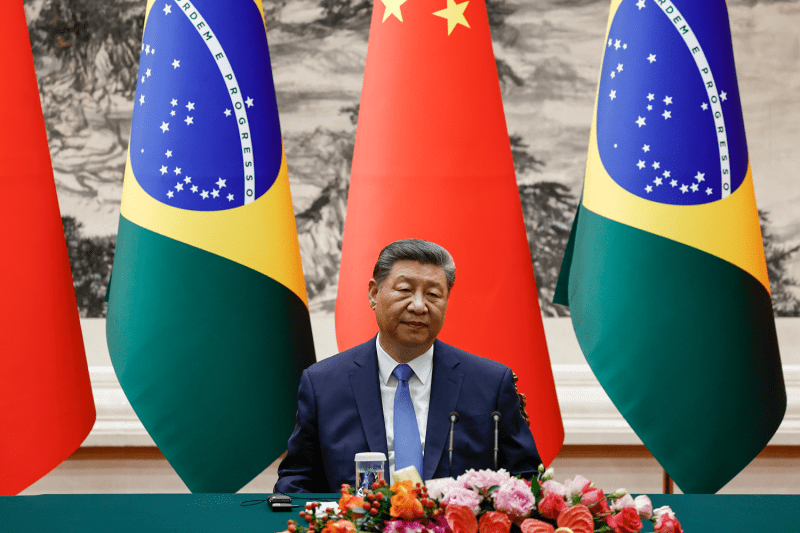
Join the Conversation
Commenting on this and other recent articles is just one benefit of a Foreign Policy subscription.
Already a subscriber?
.
Subscribe
Subscribe
View Comments
Join the Conversation
Join the conversation on this and other recent Foreign Policy articles when you subscribe now.
Subscribe
Subscribe
Not your account?
View Comments
Join the Conversation
Please follow our comment guidelines, stay on topic, and be civil, courteous, and respectful of others’ beliefs.
Change your username |
Log out
Change your username:
CANCEL
Confirm your username to get started.
The default username below has been generated using the first name and last initial on your FP subscriber account. Usernames may be updated at any time and must not contain inappropriate or offensive language.